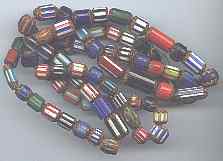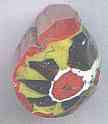The Bead Site =Home> Bead Research > Identification > chevrons
Bead Identification Certificate 6-00
12 September 2000 - update
I got a full cash refund on the beads. The shop owner seemed genuinely surprised --
though I couldn't tell if this was because he didn't know the beads were worthless or he didn't think I would check them out.
He read your certificate twice, thoroughly, before giving me the cash. I left him a copy. I'd love to know where he got the beads but I didn't ask.
Thanks again, so much, for your advice and assistance.
10 August 2000
Background: We are new to beads, but do love them. We saw these in a shop priced at $250. The dealer told us they were trade beads made in Europe in the 1800s. We bargained hard for them and thought we were lucky to get them for only $150.
When we got home we looked in your book, Beads of the World and thought that they might be even older than the 1900s. Then we showed them to another dealer who told us that they were made in India and were no more than five years old.
Help! What are they?
|
Tests:
Visual:
To be honest, I knew they were Indian right away. I nonetheless examined a number of them by looking at the ends under a magnifying glass. The canes from which the beads were cut were not molded, as Venetian canes are, but built up while hot by the "hot strip" method, as used in the village of Purdalpur, India.
|
For more on non-standard chevrons, see this gallery.
Fluorescence:
Many colors on these beads fluoresced, especially under a short-wave UV lamp. They included white, greens, blues and reds. This is typical of modern glasses.
In ancient or older glasses one might have white fluorescing due to the presence of tin.
The other colors would rarely fluoresce. Most telling is the translucent (ruby) red, which fluoresced bright orange due to the use of selenium, not even experimentally put in glass until 1891. Selenium is expensive and ruby glass the most costly glass in India.
But ruby glass is widely popular, especially for bangles.
Further Observations:
The beads had been purposely dirtied to make them look old.
__________________________________________________
Small Bead Businesses | Beading & Beadwork | Ancient Beads | Trade Beads
Beadmaking & Materials | Bead Uses | Researching Beads | Beads and People
Center for Bead Research | Book Store | Free Store | Bead Bazaar
Shopping Mall | The Bead Auction | Galleries | People | Events
The Bead Site Home | Chat Line | Contact Us | Site Search Engine | FAQ

 A waster of a mosaic cane I picked up in Purdalpur.
A waster of a mosaic cane I picked up in Purdalpur. white and red "teeth" are continuous and were made by layering each color and molding them into a "saw tooth" pattern.
white and red "teeth" are continuous and were made by layering each color and molding them into a "saw tooth" pattern.